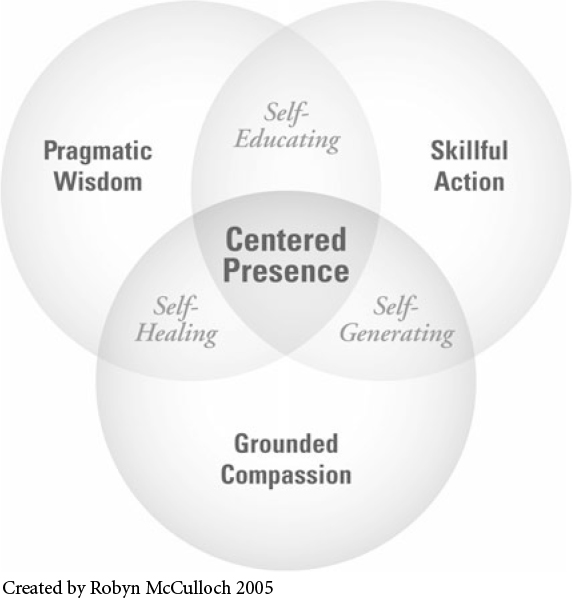21
RICHARD STROZZI-HECKLER
Leadership Dojo
Knowledge is only a rumor until it’s in the muscle.
—Asian proverb
The Largest Pharmaceutical Merger in History

Pharmaceutical giant Pfizer acquired Werner Lambert in 2001, and Pharmacia two years later, in one of the largest mergers in U.S. history. In the midst of these acquisitions, Pfizer also created a new R&D (research and development) business model that included a matrix organizational structure. While immediate attention on the implementation of the new business processes and organization was required, it also necessitated transforming the diverse cultures of these three mega pharmaceutical companies into a single, unified entity. It was as if you were suddenly asked to blend the army, navy, and air force into one high-performing service.
Dr. Nancy Hutson, senior vice president of Global Research and Development committed to building this new business culture. She knew that it would take more than capitalization and a new organizational model to successfully move Pfizer into the twenty-first century—the culture also had to be radically transformed.
The climate in Pfizer was historically competitive, hierarchical, and guarded. Hutson understood that a culture of engagement, authenticity, and trust was needed to make Pfizer both a business success and a place in which people were personally and professionally fulfilled. In short, she wanted everyone to see themselves as leaders, with the skills and sensibility to act accordingly.
The Leadership Dojo was first initiated with the Groton Leadership Team—16 senior leaders who ran the R&D Lab at Groton. We began with two four-day off-site retreats and then took the work to the next level of 150 managers in two two-day conferences. The methodology of the Leadership Dojo was immediately implemented and the participants got real business done while building their leadership skills and a team culture. Dr. Hutson declared, “The Leadership Dojo shifted the culture from one of indifference and infighting to inclusion and colleague engagement.”
Frequently Asked Questions

WHAT IS THE LEADERSHIP DOJO?
Dojo is from Japanese and translates to “Place of Training.” True to its name, the Leadership Dojo is based in mind/body/spirit practices. The Leadership Dojo is not about watching Power-Point presentations, listening to lectures, or reviewing papers. It’s an interactive process that awakens the wisdom of the body. The methodology captures our biological thrust for wholeness to transform organizations into places where people look forward to going and engaging with others. Figure 1 represents the foundational principles practiced in Leadership Dojo programs.

Figure 1. The Leadership Dojo Model
We stand out from other methods in our emphasis on learning through the body. We get people on their feet and teach them physically how to use their energy to be centered and grounded, to coordinate with others, and extend into the future. We use many practices from the martial arts, specifically Aikido,1 but they are not martial in the sense of throws or punches. For example, one person will grab his or her partner’s wrist. Grabbing the other person is a literal and physical disruption, which is also a rich metaphor of a disruption in the organization. This engages the person’s fight, flight, or freeze pattern and in a very direct way, the person being grabbed becomes aware of his or her automatic, conditioned response to change. They center and practice the moves to blend with the change, lead the change, and innovate in the change instead of reacting in a reflexive way.
In mergers and acquisitions, employees tend to take opposing views of the other culture. One of the practices we have them do in their new teams is a simple move from Aikido—turning while standing. They practice this in various configurations with everyone taking part. Coordinating together in movement lessens the grip of their oppositional stance and their inherent biological drive for cooperation is brought to the foreground.
These processes teach the person to take new actions, not just to be “head smart.” The learning shifts the story and body of the individuals and therefore the organization. The cost of not including the body in organizational change is increased stress disorders, emotional disengagement, and moods of resentment and resignation. This enormously impacts creativity and productivity. Figure 2 represents the practices, qualities, and actions of an Embodied Leader.

Figure 2. Developing Leadership Presence
WHAT ARE THE OUTCOMES?
There are two things that occur in the Leadership Dojo. First, individuals and teams learn a common language, distinctions, and practices for building trust, listening respectfully to others, generating positive moods, creating a shared vision, managing and fulfilling commitments, having conversations for action, and being lifelong learners. These are all connected to and measured by a return on a business investment. At a deeper level, it allows people to bring their purpose—what they care about—into their professional life. This creates mature, wise leaders who can act decisively and thoughtfully.
Table of Uses


About the Author

Richard Strozzi-Heckler ([email protected]) has a Ph.D. in psychology and a sixth-degree black belt in Aikido. He was featured on the front page of the Wall Street Journal in 2000 for the groundbreaking leadership program developed for the U.S. Marine Corps. In 2004, he was named one of the top 50 executive coaches in The Art and Practice of Leadership Coaching. Strozzi-Heckler has authored six books, including the nationally acclaimed In Search of the Warrior Spirit.
Where to Go for More Information

REFERENCES
Strozzi-Heckler, Richard. The Anatomy of Change. Boulder, CO: Shambhala, 1984.
———. Holding the Center. Berkeley, CA: Frog Publications, 1997.
———. In Search of the Warrior Spirit. Berkeley, CA: North Atlantic Press, 2003.
———, ed. Being Human at Work. Berkeley, CA: North Atlantic Press, 2003.
ORGANIZATION
Strozzi Institute—www.strozziinstitute.com
1. Aikido is a modern Japanese martial art that emphasizes the nonviolent resolution of conflict. It’s characterized by blending with the energy of the attacker to neutralize his or her aggression instead of harming the person.
